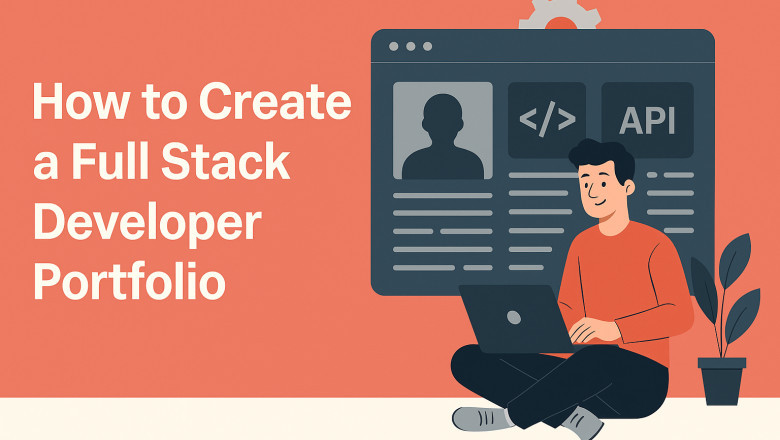views
In today’s competitive tech industry, having a comprehensive portfolio is essential for any full stack developer. Whether you're an intern, freelancer, or working full-time, your portfolio acts as your digital resume—demonstrating your abilities and potential. It's often the first thing hiring managers or clients review to assess your coding skills, creativity, and approach to problem-solving.
Related Read: Power BI vs. Tableau – Choosing the Right Data Analyst Course
A strong portfolio showcases not just technical know-how—like frontend and backend development—but also practical experience in building full applications, integrating APIs, and applying UI/UX principles. It sets you apart from others who may list skills without any supporting evidence.
At Fusion Software Institute, we emphasize practical experience. Our full stack development courses focus on hands-on project work, helping students build portfolios that reflect their capabilities and increase their job prospects.
Key Components of a Strong Portfolio
A portfolio should do more than display your projects—it should tell your story as a developer and reflect your growth and versatility.
1. Compelling “About Me” Section
Kick things off with a short personal introduction. Talk about who you are, what drives your passion for development, and the kind of work you enjoy. This humanizes your profile and makes it relatable.
2. Clearly Listed Technical Skills
Highlight your proficiency with programming languages, tools, and frameworks. For example:
-
Frontend: HTML, CSS, JavaScript, React
-
Backend: Node.js, Express
-
Database: MongoDB, MySQL
-
Tools: Git, GitHub, Postman, Docker
Fusion’s curriculum is designed to align with in-demand technologies, ensuring your skills are market-relevant.
3. GitHub Profile
Include a link to your GitHub to demonstrate code quality, use of version control, and collaboration history. Well-organized and documented code makes a strong impression.
4. Live Project Links
Host and link live demos using platforms like Netlify, Vercel, or GitHub Pages. Letting visitors interact with your apps adds immediate credibility.
5. Project Case Studies
Go beyond code—explain your thought process. Describe project goals, tools used, challenges faced, and how you solved them. This demonstrates your problem-solving and end-to-end development abilities.
6. Blog Posts or Technical Articles (Optional)
If you enjoy writing, include blogs or tutorials to showcase what you've learned. This not only shows initiative but also builds your personal brand.
Types of Projects to Showcase
Variety and depth in your projects can greatly influence how employers or clients perceive your skills. Here are key project types to include:
-
CRUD Apps: Examples like task managers or blogs that demonstrate data operations.
-
E-commerce or Booking Systems: Showcases handling of transactions, user interactions, and dynamic content.
-
API Integrations: Apps using third-party APIs (weather, payments, maps) show adaptability.
-
Authentication Systems: Projects with secure login/signup using JWT or OAuth indicate knowledge of security.
-
Community/Personal Platforms: Forums, portfolios, or event apps show initiative and practical thinking.
Fusion’s training ensures students build these project types, preparing them for the real world.
Presenting Your Portfolio Professionally
Great projects need great presentation. Here’s how to showcase your work effectively:
Clean, User-Friendly Design
Ensure your portfolio is easy to navigate, responsive, and visually appealing. Treat it as your personal UI/UX showcase.
Host Online
Use free and reliable platforms like GitHub Pages, Netlify, or Vercel to make your work accessible anytime.
Use a Custom Domain
A personalized domain (e.g., yourname.dev) adds professionalism and memorability.
Add Key Links
Include a downloadable resume, LinkedIn profile, and GitHub icon. Make it simple for people to connect with you.
How Fusion Software Institute Supports Your Portfolio Growth
At Fusion Software Institute, we understand that a powerful portfolio is key to a successful career in tech. That’s why our program focuses on:
Real-World, Project-Based Learning
From day one, you'll build real applications. By course completion, you’ll have a diverse and professional portfolio.
Mentorship and Code Reviews
Learn from experienced instructors who provide detailed feedback, helping you meet industry standards.
Career Support
We go beyond coding. You’ll get help with resumes, mock interviews, and in-depth portfolio reviews—ensuring you're prepared to launch your career.
With Fusion, you don’t just learn how to code—you learn how to stand out.
Conclusion
Creating a full stack portfolio is one of the most impactful steps toward starting a tech career. It reflects your knowledge, practical application, and problem-solving abilities.
It’s not just about technical skills—it’s about storytelling, presentation, and professional branding. With expert guidance, the journey becomes more structured and rewarding.
At Fusion Software Institute, we’re committed to helping you build a portfolio that does more than tick boxes—it opens doors.
? Contact us: 9890647273 or 7498992609
Visit here: https://www.fusion-institute.com/how-to-build-a-portfolio-as-a-full-stack-developer






















Comments
0 comment